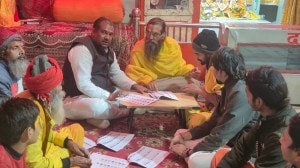Lines of Thought
An ongoing exhibition in the Capital puts the spotlight on two of Indias extinct folk art forms.
An ongoing exhibition in the Capital puts the spotlight on two of Indias extinct folk art forms.
Located around 350 kilometres from Mumbai,Pinguli might not feature as an art centre on the map of modern Maharashtra,but once upon a time,it was the heartland. Its narrow lanes were the stage for innumerable nomadic puppeteers,who roamed through the Konkan belt with artwork depicting myriad epics and legends. They were part of a team while the artist held his painting depicting various scenes from a tale,another chitrakar modulated his voice to create drama and enact the narrative backed by vocalists and musical instruments. It must have been spectacular, notes Meena Varma,director of the Delhi-based Arts of the Earth gallery,as she glances at some of these paintings. The genre that had its golden era in the 17th century,under the rule of Raja Khem Sawant Bhosale of the state of Sawantwadi,is now being celebrated at her gallery in an exhibition titled Pinguli Chitragathi and Folk Paintings of Rajasthan.
The collection is dedicated to the art that flourished in 16th century Rajasthan and 18th century Maharashtra. This was the era when art entertained as well as documented the times. Some of the Pinguli artists belonging to the Thakar Adivasi community were even appointed by royalty,especially Shivaji Maharaj,for political espionage,as they travelled from village to village down the Konkan coast till they reached Karwar,which is now part of coastal Karnataka, observes Varma,pointing out that both the art forms are now extinct.
While she purchased the Rajasthani miniatures from a collector a couple of years back,the Pinguli Chitragathi works were bought in Pinguli almost 20 years ago,when Varma travelled to the region. The art practice was already extinct. Dwindling patronage for folk art has compelled artists to take up alternative means of livelihood such as farming and fishing, she adds.
Apart from the shared fate of being lost in time,the two genres have clean lines and are sans detailing,unlike the Orissa patachitras and kalamkari from Andhra. Occupying facing walls of the gallery,the works on paper are bereft of the musical accompaniments that supported them in those times,but speak of the past nevertheless. Pinguli is characterised by bright hues and side-profiles painted in natural dyes. The episodes depicting Ramayana range from Jatayu being slashed by Ravan to Ram,and Lakshman searching for Sita.
The miniatures,on the other hand,document the life and times of the period and the strife between good and evil. Belonging to the Mewar School that distanced itself from the Mughal style,these are defined by sharp features and bold lines. This school flourished in Udaipur in the 16th century and was later revived towards the end of the 17th century,but it eventually declined, says Varma,adding that the exhibition is a means to spread awareness about the folk forms.
Even as she shares details of the genre with the art connoisseurs of the Capital,the gallerist is looking forward to another trip to Pinguli. It would be in vain to look for the artists but perhaps,I could obtain some artwork in the region, she adds.
The exhibition at Arts of the Earth,F-213 A,Lado Sarai,is on till July 28.
Contact: 47543652
- 01
- 02
- 03
- 04
- 05































